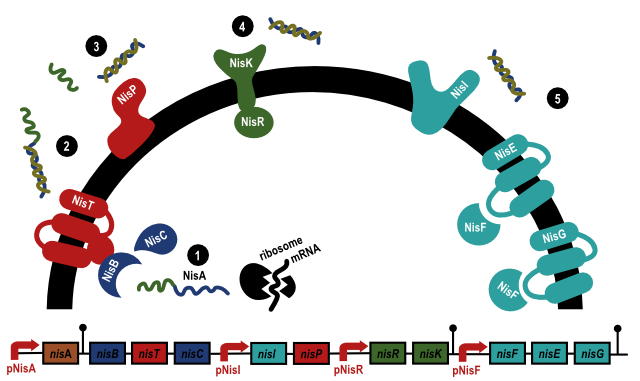Part:BBa_K1365003
NisC
Usage and Biology
NisC catalyzes the ring formation in the nisin precursor protein NisA (BBa_K1365000). Together with the genes NisA, NisB, NisT, NisP, NisR and NisK it is responsible for producing the lantibiotic nisin in Lactococcus lactis. see the figure below. The NisA protein is first modified and then transported out of the cell. The serines and threonines of NisA are dehydrated by NisB and then the precursor is cyclized by NisC. After this process, the precursor is transported out of the cell (2). Here, the lead peptide is cut off by NisP (3) and the mature nisin is formed.1
Nisin is a lantibiotic, an bacteriocidal peptide. Nisin inhibits the growth of a broad range of Gram positive bacteria, of which many are spoilage bacteria or pathogens. Nisin is therefore extensively used in the food industry as a preservative. Nisin forms pores in the membrane of the bacteria it kills and inhibits the peptidoglycan synthesis.2
Sequence and features
- 10COMPATIBLE WITH RFC[10]
- 12COMPATIBLE WITH RFC[12]
- 21COMPATIBLE WITH RFC[21]
- 23COMPATIBLE WITH RFC[23]
- 25COMPATIBLE WITH RFC[25]
- 1000COMPATIBLE WITH RFC[1000]
References
1. Cheigh, C. I. and Pyun, Y.R. (2005) Nisin biosynthesis and its properties. Biotechnol. Lett. 27: 1641-1648
2. Zhou, H. et al. (2014) Mechanisms of nisin resistance in Gram-positive bacteria. Ann. Microbiol. 64: 413-420
| None |

